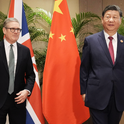The shocking images coming from Aleppo in recent weeks are a stark reminder that there still seems no end in sight for Syria's brutal civil war, now well into its fifth year. Over 500,000 have been killed and five million are refugees. What began as a largely peaceful revolt against Bashar al-Assad’s dictatorship has now morphed into a brutal, multi-facetted conflict with heavy international involvement. Might international players hold the key to the war’s overdue end?
International interventions in civil wars are nothing new and political scientists have long sought to analyse their impact. Several studies show that while heavy intervention on one side can bring about a swift end to a civil war, “balanced interventions,” when multiple actors intervene on each side, prolong conflict by creating a stalemate. Syria is a clear case of such a balanced intervention. From the beginning of the war Assad's allies, Russia and Iran, have been willing to commit more to helping the regime than its foreign enemies—Saudi Arabia, Qatar, Turkey and the west—have to toppling it. By providing weapons, money, diplomatic support and more recently troops and airpower, Moscow and Tehran have ensured the regime’s medium-term survival. However, they have not solved Assad’s chronic manpower shortage, making it difficult for the regime to reconquer and hold hostile lost territory. Assad’s enemies have given the rebels money and weapons, but this has been hampered by western reluctance about the involvement of radical jihadists in the opposition and by rivalry among Riyadh, Doha and Ankara. While the rebels gained sufficient support to remain in the field in some capacity, they have never received support that matches that given to Assad. Toppling the Syrian dictator by military means is extremely unlikely.
Negotiation rather than military victory has therefore long seemed the most likely way the conflict can end. However, as seen by the failure of peace processes in 2012, 2014 and this year neither the regime nor the rebels seem willing to make significant compromises (primarily on whether Assad can remain as president) and their external backers have proved unwilling or unable to pressure them.
Again, political science offers some explanations for this. In past civil conflicts, belligerents have only seriously negotiated when they feel they will gain more from peace talks than war. This tends to happen when actors have reached a “hurting stalemate”: when continuing the war is more costly than compromise. However, neither of Assad’s key international allies are currently in such a position. Both Iran and Russia have lost personnel since both stepped up their involvement in 2015, but with Russia losing around 20 and Iran 400 men, not enough body bags are arriving home to create significant domestic pressure for them to change their policy on Syria. Nor is either really financially burdened by the campaign: Russia is reportedly spending $4m a day in Syria, but with an annual defence budget of $50bn this is affordable, despite the weak state of Russia’s economy. Likewise, Iran’s anticipated economic opening after the end of western sanctions gives it more money to pour into the campaign. Of the rebels’ key supporters, Saudi Arabia is not hurting either. Again, its economy is struggling with low oil prices, but the financial support sent to the rebels is still easily affordable. Moreover, unlike Syria’s neighbours, Saudi Arabia has not suffered the conflict’s immediate spillover in the form of refugees or radical militants, so has little incentive to shift its approach.
The two key external players that are hurting are the west and Turkey. Unsurprisingly, these are the actors seemingly most willing to change position. Turkey, struggling with over two million Syrian refugees and multiple terror attacks from Islamic State (IS) and Kurdish groups linked to the Syrian war, has recently softened its line. A growing rapprochement with Russia has seen prime minister Binali Yldrm suggest there is some leeway on Assad’s future, previously a red line for Ankara. Damascus seems open to this new stance, symbolically bombing Turkey’s Kurdish enemies in Hasakeh last week. European leaders, suffering from the migrant crisis and increased IS terrorism have also hinted at a softer line on Assad, with various leaders suggesting the Syrian president may not have to leave immediately, while US Secretary of State John Kerry is reportedly in deep discussions with Moscow about a possible settlement. However, even though Turkey and the west are hurting, both have invested heavily in the Syrian opposition and it seems unlikely either is at a point to cut their losses and walk away, which would represent an unacceptable loss in international prestige.
So what might change to make these key international actors hurt more and take negotiations more seriously? The election of a new US president in November may shift Washington’s approach. Some hope that Hillary Clinton, who advocated more action in Syria as Secretary of State and is closer to the anti-Assad Gulf states than Barack Obama is, will adopt a more aggressive stance, such as deploying a no-fly zone over rebel held areas or sending better weaponry. However, to escalate the US presence to the point that Russia and Iran begin “hurting” sufficiently to compromise would require a major commitment of US military resources. It would risk retaliation from Russia in an arena that the US has not historically seen as in its vital interest—an argument regularly made by Barack Obama for his own limited involvement. Moreover, US presidents rarely seek out major conflicts “of choice” early in their first term in office, fearing a quagmire that may damage their reelection prospects. Crucially, outside the DC Beltway, there is little domestic demand for the US to play a more active role in Syria.
Alternatively, should Donald Trump be elected, with his preference for a reduced international role for the US, it is possible he might entertain a deal with Vladimir Putin, perhaps keeping Assad in power and ending US support for the rebels. However, were Trump even to entertain such a potentially humiliating climbdown, there is no guarantee that allowing Assad to “win” would end the war. As discussed, even with Russian and Iranian assistance, Assad lacks the manpower to reconquer all of Syria. Large stretches of territory would remain potentially dangerous “ungoverned spaces” controlled by rebel groups, the Kurds, IS and new groups that may yet emerge. Moreover, Saudi Arabia and possibly Turkey would be unlikely to accept such an outcome and, with their ties to the US already strained, would likely keep backing anti-Assad forces, continuing the war in some form.
Sadly then, it seems unlikely that enough key foreign actors in the Syrian civil war will experience enough hurt to end the conflict any time soon. A change in US president does not seem likely to prompt such a shift. More dramatic but less likely changes seem necessary, such as a major shift in Russian, Iranian or Saudi policy. In their absence, Syria’s brutal civil war looks set to continue.
Christopher Phillips's latest book, "The Battle for Syria," is published by Yale on 15th September
The US and Russia could help end the Syria conflict
But are they hurting enough?
August 26, 2016

A child rides his bike past buildings destroyed in Syria's civil war, Douma, near Damascus, 1st March 2016 ©NurPhoto/SIPA USA/PA Images












